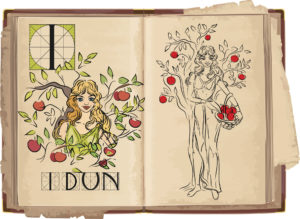
Do deities really exist, or did humans create them to assign meaning to aspects of the world around them? Regardless of the answer, the religious texts, literature, and mythology of pre-Christian cultures still provide a fascinating window into how our ancestors viewed themselves and their environments. Several religious cosmologies purport that supernatural entities exist within complex hierarchies or groups, with deities performing special jobs to help run the natural world. One Norse goddess, Idun, plays a key role in keeping the natives of Asgard young and powerful.
An Introduction to Idun
It’s not surprising if you’ve never heard of Idun. After all, she doesn’t get nearly as much press as Loki, Thor, or Frigga, and unlike those three, she hasn’t yet appeared in any Marvel cinematic releases. Yet she’s an important member of the Norse pantheon, described by the Encyclopedia Britannica as the goddess of rejuvenation and spring. Her New World Encyclopedia entry reveals that she’s also the spouse of Bragi, the god of poetry.
To understand how the ancient Norse viewed their deities, it’s vital to comprehend what we know about their classification system for the Asgardians in their mythoi. In Norse writings, most supernatural beings tended to fall into one of three categories:
- Aesir, gods of war and conquest
- Vanir, deities of wisdom, wealth, and fertility
- Jotun, a malicious race of giants who warred against the gods
These classifications come from modern interpretations of older writings, but this distinction isn’t always so clear-cut. Moreover, both the Prose and Poetic Eddas sometimes use the term “Aesir” when collectively referring to all Norse gods. Writings that specifically mention Idun classify her as a Vanir, which makes sense given her role in helping the other deities remain forever young and vigorous.
Keeper of the Sacred Apples
In Norse myths, Idun tends a garden of golden apples that bestow youth and immortality. These prized delicious fruits were naturally coveted by the Jotun, who were forbidden from consuming them due to their evil deeds. Unsurprisingly, a giant named Thiassi hatched a plan to kidnap her and steal the apples. Thiassi kidnapped Loki and coerced him into luring Idun out of the grove and into the giant’s clutches.
According to the Prose Edda, the denizens of Valhalla began to age without the apples and demanded Loki’s help with her rescue. After Freya lent him a magical robe to aid him in making his getaway, he liberated the goddess by transforming her into a nut and flying away. When Thiassi shapeshifted into an eagle and gave chase, Loki lured him into Asgard, where he was set on fire by the remaining gods.
Idun in Contemporary Culture
Although Idun’s kidnapping and the theft of her apples are what most may remember about her, she continues to make her mark in modern times. The Troth, an eminent organization among universalist and inclusive Heathenry groups, named its quarterly journal Idunna in her honor. Not only that, a fictionalized version of her lives on in the Marvel comic universe. According to the fan-edited Marvel Database, she has appeared in 54 separate comic book issues to date. Idun belongs to the Asgardians, an extra-dimension race of beings just like the Kemetic Ennead or the Hellenistic Olympians. As in the original Norse legends, she is also the custodian of lifegiving golden apples.
Many belief systems come with multifaceted interrelationships between deities, spirits, and elements of the natural world. We may see some of these ancient figures as “major” or “minor” but sometimes overlook the roles they play within these ancient worldviews. The Prose Edda’s account of Idun’s kidnapping is only one of many examples. While it is one of the few writings about her that’s survived to modern times, it illustrates the importance of this goddess within Norse cosmology.

